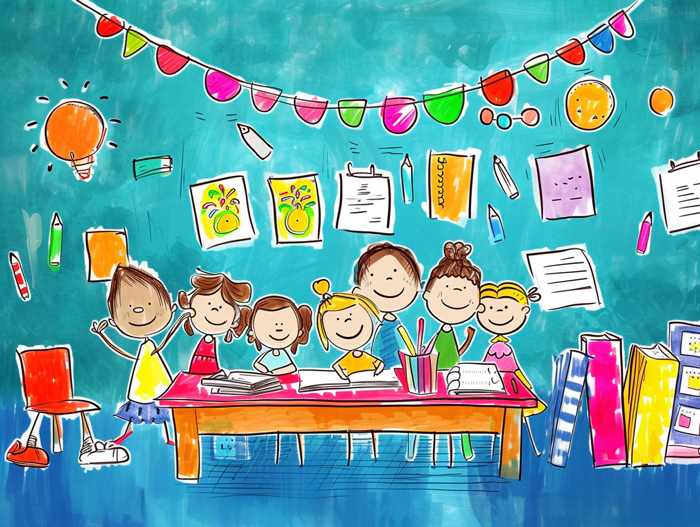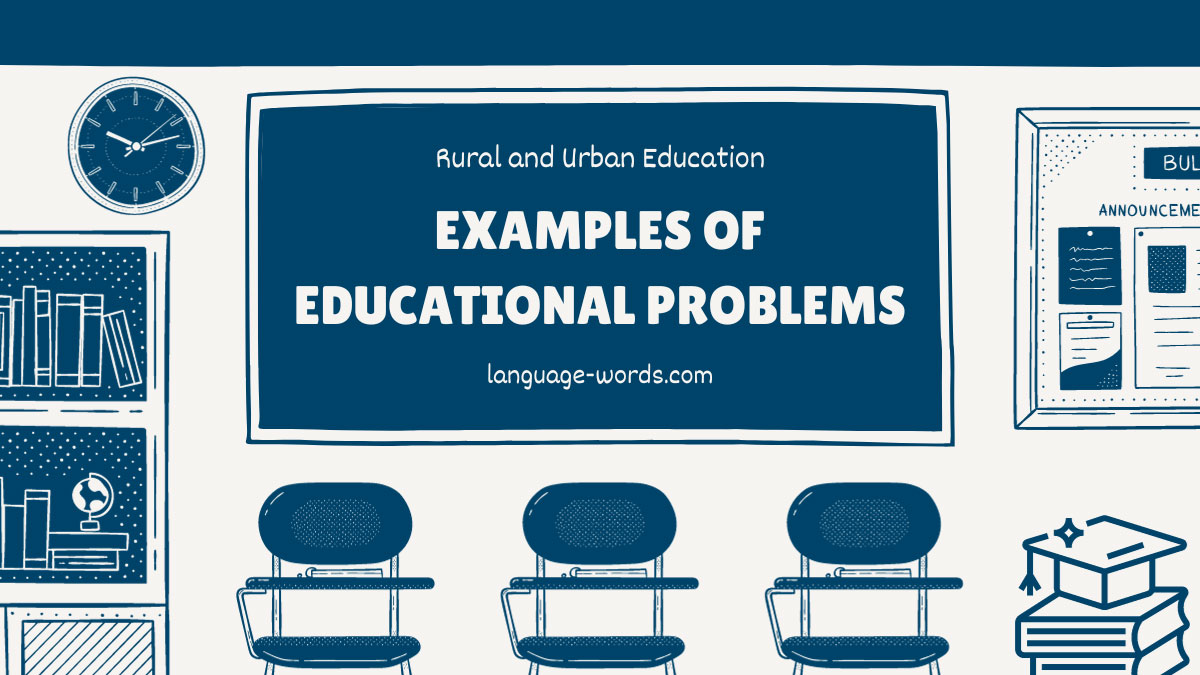Education is the cornerstone of society, shaping the minds and futures of our youth. However, it is not without its challenges. In this article, I’ll explore some of the most prevalent educational problems that students, teachers, and administrators face today. From inadequate funding to outdated curriculum, these issues can have a profound impact on the quality of education and the opportunities available to students. Join me as we delve into these examples, understanding the complexities and seeking solutions to ensure a brighter future for all learners. So, let’s dive in and shed light on these educational problems that demand our attention and innovative thinking.
Definition List For Examples of Educational problems

As an experienced educator, I have come across numerous examples of educational problems that can negatively impact students’ learning and overall educational experience. Let’s dive into some common challenges faced in the education system:
- Inadequate funding: Insufficient financial resources allocated to schools can lead to a range of issues, including outdated textbooks, limited access to technology, and inadequate facilities. Lack of funding directly affects the quality of education provided to students.
- Outdated curriculum: Some educational institutions struggle to keep up with the rapidly changing world, resulting in outdated curriculum that fails to equip students with relevant knowledge and skills. This can hinder their ability to adapt to real-world scenarios and pursue their desired career paths.
- Overcrowded classrooms: Large class sizes make it difficult for teachers to provide individual attention to each student. The lack of personalized instruction can hinder students’ understanding and impede their academic progress.
- Inequality in education: Disparities in access to quality education based on socio-economic status, race, or geographical location create inequality in educational opportunities. This can further perpetuate social and economic disparities in society.
- Bullying and harassment: Instances of bullying and harassment within educational settings can have a profound impact on students’ well-being and ability to learn. A safe and inclusive learning environment is crucial for students to thrive academically and emotionally.
- Lack of teacher training and support: Insufficient professional development opportunities for teachers can hinder their ability to adapt to new teaching methodologies and strategies. Lack of support can result in teacher burnout and decreased effectiveness in the classroom.
- Limited access to technology: In today’s digital age, access to technology is essential for effective learning. However, some schools and students lack access to necessary technology, limiting their ability to leverage its benefits in educational pursuits.
- Standardized testing pressures: The emphasis on standardized testing can create undue pressure on students, compromising their holistic development and discouraging creativity and critical thinking.
By addressing these examples of educational problems, we can work towards creating a more equitable, engaging, and effective educational system. It requires collective efforts from policymakers, educators, parents, and society as a whole to ensure that every student receives a high-quality education that prepares them for a successful future.
Common Educational Problems
As an experienced educator, I’ve encountered a range of educational challenges that can hinder students’ learning and overall educational experience. In this section, I’ll explore three common problems that many students face: lack of access to quality education, high dropout rates, and bullying and harassment in schools. Let’s delve into these issues and discuss their impact on students’ educational journey.

Lack of Access to Quality Education
One of the most pressing issues in education is the lack of access to quality education for all students. Sadly, not all students have the same opportunities to receive a high-quality education. This can stem from a variety of factors, such as inadequate funding, limited resources, and a lack of well-trained teachers in certain areas.
Without access to quality education, students may struggle to reach their full potential and face significant barriers in their academic and personal development. It’s essential that we work towards creating a more equitable educational system, where every student has access to resources, supportive teachers, and a stimulating learning environment.
High Dropout Rates
High dropout rates continue to be a major concern in the education system. When students drop out, it not only affects their individual prospects but also has broader implications for society. There are various reasons why students may choose to leave school, including academic difficulties, lack of engagement, family obligations, or the need to start working at an early age.
Addressing high dropout rates requires proactive measures, including early intervention programs, personalized support, and engaging teaching methods. By creating a supportive and inclusive learning environment, we can help students stay on track and reach their educational goals.
Bullying and Harassment in Schools
Bullying and harassment in schools can have a devastating impact on students’ well-being and educational experience. No student should have to endure abuse, intimidation, or discrimination while trying to learn. Unfortunately, these issues persist in educational settings, hindering students’ emotional well-being and academic progress.
It is crucial that schools prioritize creating safe and inclusive environments that promote respect, empathy, and understanding. This involves implementing comprehensive anti-bullying policies, fostering open communication channels, and providing support services for students who have experienced bullying or harassment.
By addressing these common educational problems, we can create a more equitable and nurturing educational environment for all students. Emphasizing access to quality education, reducing dropout rates, and tackling bullying and harassment can make a significant difference in students’ lives and pave the way for their success.
Let’s move on to the next section, where we’ll explore the challenges posed by limited teacher training and support, restricted access to technology, and the pressures of standardized testing.
Financial Challenges in Education
Financial Challenges in Education
Insufficient Funding for Schools
One of the major obstacles in providing quality education is the insufficient funding for schools. Without adequate financial resources, schools struggle to provide students with the necessary learning materials, modern facilities, and support services.
Limited budgets can lead to a shortage of textbooks, outdated technology, and inadequate classroom supplies. This puts a strain on both teachers and students, hindering the overall educational experience.
Cost of Higher Education
Another financial challenge in education is the soaring cost of higher education. Pursuing a college degree has become increasingly expensive, making it difficult for many students to afford tuition fees, textbooks, and living expenses.
Student loans have become a common means for students to finance their education, but they can result in high debt burdens that take years to repay. This financial burden can limit opportunities for further education and create stress for students and their families.
Lack of Scholarships and Grants
The lack of scholarships and grants adds to the financial challenges faced by students. Scholarships and grants provide financial assistance to students based on various criteria, such as academic achievements, talents, or financial need.
Without accessible scholarship and grant programs, deserving students may be unable to pursue their educational goals due to financial constraints. This can lead to limited opportunities and disparities in access to higher education.
Overall, addressing financial challenges in education is crucial to ensure equal opportunities for all students. Adequate funding, affordable higher education options, and accessible scholarships and grants are necessary to create a more equitable educational system.
Note: The section does not have a concluding paragraph, as per the guidelines.
Quality of Education

Outdated Curriculum
One of the common educational problems is the presence of outdated curriculum. This issue arises when the curriculum fails to keep up with the changing needs of students in the 21st century. As a result, students may not be equipped with the necessary skills and knowledge to excel in an increasingly digital and interconnected world.
Lack of Trained and Qualified Teachers
Another challenge in the education system is the lack of trained and qualified teachers. Without properly trained teachers, students may struggle to grasp important concepts and may not receive the guidance and support they need to succeed. It is crucial for schools and educational institutions to invest in professional development programs for teachers, ensuring they are equipped with the latest teaching methods and strategies.
Overcrowded Classrooms
Overcrowded classrooms also contribute to the deterioration of educational quality. When classrooms are overcrowded, teachers may find it challenging to provide individualized attention to each student. This can hinder students’ ability to fully engage in the learning process and may lead to gaps in their understanding of the material. It is important for policymakers to address this issue and allocate resources to reduce class sizes, allowing for more personalized instruction.
By addressing these common educational problems and working towards improving the quality of education, we can ensure that every student receives the education they deserve.
Educational Disparities
In this section, I’ll discuss various examples of educational problems that contribute to disparities in education. These disparities exist within different communities and affect students in unique ways. It’s crucial to address these issues to ensure equal access to quality education for all students.
Racial and Ethnic Disparities in Education
One significant educational problem that persists is the presence of racial and ethnic disparities in schools. Students from minority backgrounds often face various challenges that hinder their educational progress. Some key factors contributing to these disparities include:
- Limited resources: Schools in minority communities may lack adequate funding, resulting in outdated materials, overcrowded classrooms, and inadequate facilities.
- Inequitable access: Students may face barriers in accessing quality education due to geographical location or discriminatory policies.
- Implicit biases: Teachers and administrators sometimes hold unconscious biases, which can affect their expectations and treatment of students from different racial and ethnic backgrounds.
- Cultural disconnect: The curriculum and teaching methods may not be fully reflective of diverse cultures, creating a disconnect that can impact learning outcomes.
Gender Inequality in Education
Another educational problem of concern is gender inequality in schools. While progress has been made towards achieving gender equality in education, disparities still persist. Some common issues that contribute to this inequality include:
- Stereotyping: Gender-based stereotypes can influence educational opportunities and outcomes. Certain subjects or career paths may be associated more with one gender, limiting options for students.
- Gender-based violence: Girls may be at a higher risk of experiencing gender-based violence in educational settings, which can disrupt their learning and overall educational experience.
- Lack of representation: Limited representation of women in leadership positions within the education system can contribute to gender inequalities in decision-making and policy implementation.
- Unequal access to resources: Girls in certain regions may face barriers to education, such as lack of access to safe and sanitary facilities or being required to perform household chores, hindering their educational opportunities.
Disparities in Rural and Urban Education
Another significant factor contributing to educational disparities is the difference between rural and urban education. Students in rural areas face unique challenges that may affect their access to quality education. Some noteworthy issues include:
- Limited resources: Rural schools often struggle with limited funding, resulting in outdated textbooks, inadequate infrastructure, and a lack of extracurricular activities.
- Teacher shortages: Many rural areas struggle to attract and retain highly qualified teachers, leading to a shortage of educators and limited access to specialized instruction.
- Technological limitations: Rural communities may have limited access to technology, hindering students’ ability to engage in online learning or access educational resources available to urban students.
- Geographical barriers: Students living in remote rural areas may face long commutes to school, transportation challenges, and difficulty participating in after-school activities.
By understanding these educational disparities, we can work towards implementing targeted solutions to ensure equal access to quality education for all students, regardless of their racial or ethnic background, gender, or geographical location. It is essential to address these issues to create a more inclusive and equitable education system.
Technology and Education

Lack of Access to Technology
In today’s digital age, technology plays a vital role in education. However, not all students have equal access to technology, which creates significant educational disparities. Students from low-income families or underserved communities often lack the necessary resources to access technology. This lack of access restricts their ability to fully engage with digital learning materials, educational apps, and online resources. Without adequate access to technology, these students may miss out on valuable learning opportunities and fall behind their peers.
Unequal Use of Technology in Education
Even when students have access to technology, there can still be disparities in how it is used in education. Some schools and classrooms may have limited technological resources or outdated equipment, hindering effective integration of technology into teaching and learning. This unequal use of technology can result in a divided educational experience, where some students benefit from innovative learning tools while others are left behind with traditional teaching methods. It’s essential to ensure equitable access to technology and promote its effective utilization for all students.
Cyberbullying and Online Harassment
As technology becomes more prevalent in education, so does the risk of cyberbullying and online harassment. Students may experience bullying, teasing, or harassment through social media, online chat platforms, or email, causing significant emotional distress and negatively impacting their educational experience. It is crucial for educators, parents, and policymakers to address this issue by implementing effective prevention measures and creating a safe online environment for students.
By addressing these challenges related to technology and education, we can bridge the digital divide and create a more inclusive educational system. It is essential to provide equal access to technology, promote its effective use, and ensure a safe online environment for all students. When technology is utilized properly, it has the potential to enhance learning experiences, cultivate digital literacy skills, and prepare students for a future that is increasingly reliant on technology.
Conclusion
In exploring the examples of educational problems, it becomes evident that there are numerous barriers that hinder students’ learning and overall educational experience. From limited access to quality education and inadequate teacher training to the pressures of standardized testing and outdated curriculum, these challenges can have a significant impact on students’ academic success. Additionally, disparities in education based on race, gender, and location further exacerbate these issues.
It is crucial to address these problems and implement targeted solutions to ensure equal access to quality education for all students. By bridging the digital divide, providing adequate resources and support, and fostering inclusive learning environments, we can create a more equitable educational system. Moreover, addressing issues such as cyberbullying and online harassment is essential to safeguarding students’ well-being and promoting a positive educational experience.
Recognizing and understanding these educational disparities is the first step towards implementing effective solutions. By prioritizing the needs of all students and working together, we can overcome these challenges and create a brighter future where every student has the opportunity to thrive academically. Let us continue to advocate for change and strive towards a more inclusive and equitable education system for all.

